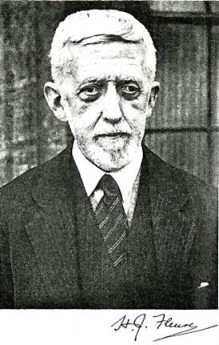H. J. Fleure facts for kids
Quick facts for kids
H. J. Fleure
FRS FRAI
|
|
|---|---|
 |
|
| Born |
Herbert John Fleure
6 June 1877 |
| Died | 1 July 1969 |
| Nationality | British |
| Alma mater | |
| Scientific career | |
| Institutions |
|
Herbert John Fleure (born June 6, 1877 – died July 1, 1969) was an important British scientist. He studied both animals (zoology) and the Earth's features (geography). He was a Fellow of the Royal Society (FRS), which is a very high honor for scientists.
Fleure held many important roles during his career. He was the secretary of the Geographical Association and the editor of their magazine, Geography. He also led several scientific groups as president. These included the Royal Anthropological Institute and the Geographical Association.
Contents
Early Life and Education
Herbert John Fleure was born on June 6, 1877, in Guernsey. This is one of the Channel Islands. His parents were Jean Fleure and Marie Le Rougetel.
In 1897, he started studying at the University of Wales, Aberystwyth. While there, he helped create the Student Representative Council. This group helps students have a say in university matters. He earned his science degree with top honors in 1901. After that, he continued his studies in Zurich, Switzerland, focusing on zoology.
A Career in Science
After his studies, Fleure returned to Wales. In 1908, he became the head of the Zoology Department at Aberystwyth University. He helped other professors with important projects. One project was an exhibition about cities and town planning in Dublin in 1914.
From 1917, he taught both anthropology (the study of human societies) and geography at the university. He held this position until 1930. Then, he moved to Victoria University in Manchester. There, he became a professor of geography. In 1936, he was made a Fellow of the Royal Society. This is a prestigious group for leading scientists.
After he retired in 1944, he continued to be active in science. He served as president of the Royal Anthropological Institute from 1945 to 1947.
Contributions to Guernsey
Fleure was also a founding member of the Guernsey Society. This group was started in 1943. Its goal was to represent the interests of Guernsey during World War II. At that time, the island was occupied by Nazi forces.
After the war, he often wrote for The Quarterly Review. He also contributed to a book called The Guernsey Farmhouse. This book, published in 1964, celebrated the old family homes on the island. Fleure also wrote biographies about other scientists.
Writing and Research
From 1927 to 1956, Fleure co-authored a ten-volume series. These books were called The Corridors of Time. He wrote them with Harold John Edward Peake.
Family Life
In 1910, Herbert Fleure married Hilda Mary Bishop in King's Lynn. They had one son and one daughter. Hilda lived until 1974, outliving her husband by five years.
Awards and Recognition
Fleure received several important awards for his work.
- In 1930, he was given an Honorary Fellowship from the American Geographical Society.
- In 1939, he received their Daly Medal.
- In 1946, he was awarded the Victoria Medal from the Royal Geographical Society.
Key Publications
Fleure wrote many books and articles during his career. Here are some of his notable works:
- Human Geography in Western Europe (1918)
- The Peoples of Europe (1922)
- Races of England and Wales (1923)
- French Life and its Problems (1942)
- A Natural History of Man in Britain (1951; revised edition 1969) (part of the New Naturalist series)
- The Guernsey Farmhouse (1964)

